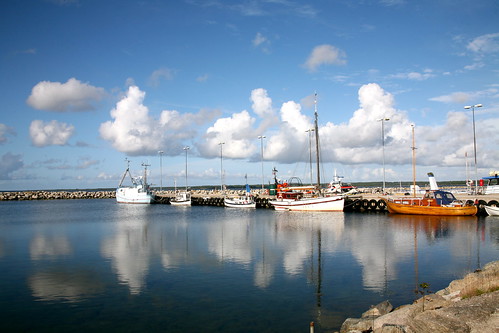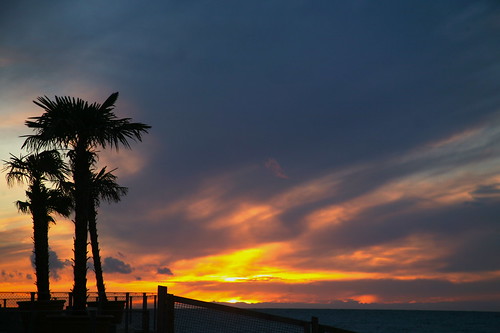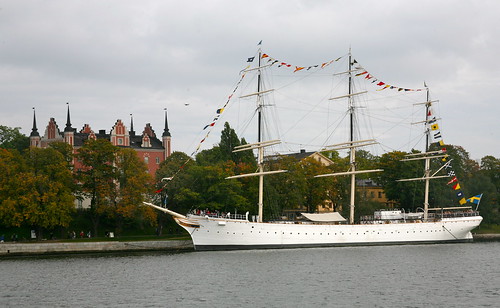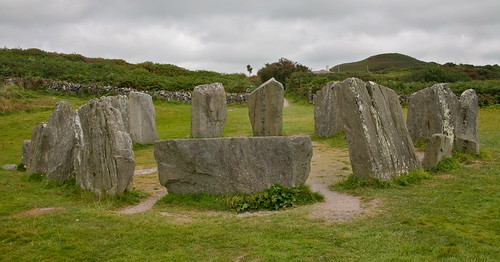Rather than go back to the hotel and sulk I decided to head to Farosund, about 50kms north of Visby. In the back of my mind I had the idea of crossing over to Faro, a much smaller island separated from Gotland by just a few hundred metres. Driving in the rain and on the wrong side of the road isn't all that much fun and there wasn't a whole lot to look at along the way, except a few churches and the odd windmill here and there.
A couple of kilometres short of Farosund I saw another Viking village/museum. It was closed too. I'm not sure when anything's actually open on Gotland.
Anyway, as I was about to leave a lady came out through the gate and said that yes, they were closed but I was welcome to go in and have a look around anyway. I wouldn't be able to go inside any of the houses, etc but could still walk around the site. So in I went, suddenly feeling a lot more positive about the day.
The museum has a number of houses (some with thatched rooves, some with tiles), stable, sheep pen, windmill (post-Viking vintage), wind-saw, a couple of waterwheel mills, tools and other artefacts, etc. Plus some runestones. I think I smiled properly for the first time for the day when I saw them. They've probably been moved here from their original homes but they looked authentic. One runestone has runic writing while another has a complete pictorial history of whoever it's a memorial to.
Just to prove I was in the right place, the sun came out. Once again, all was right with the world.

After I'd had my fill of Vikings I headed into Farosund. Crossing to Faro is by ferry but it was over the other side when I got there. So I had a wander round. There's not a lot to see besides the little harbour. I went back into town – needed the supermarket and a toilet. While I was doing that the ferry came and went. Sigh. Nevermind, I decided to head to the west coast and make my way back to Visby as I hadn't given that a proper look.

It rained on and off all the way back. I stopped at a couple of places during rain breaks – Sjalso for instance; a tiny village with a small stone pier and a few fishing boats. Pretty though.
I headed into Visby from the north and had to enter via the northern gate – a proper medieval gateway in the old city walls. Impressive. I found somewhere to park and went exploring round the old cobbled streets. Fortunately the rain seemed to have ceased by this stage.
Apart from the city walls with their towers there are numerous ruins scattered about – churches mostly. The church of St Nicolaus, an old Dominican (Blackfriars) establishment, is quite big but is basically an empty shell. There was some sort of Renaissance banquet thing being prepared for. I didn't have a ticket so had to leave. The Cathedral of Santa Maria is impressive. It's fully intact and is a working church. It has three black spires which I found interesting. The parish churches scattered around the island are all very Romanesque in style. This had a much more Russian look to it. Or, perhaps, Russian churches have a Swedish look about them – given that the original 'Russians' were a Swedish Viking mob called the Rus. Pics of Visby will be up in a day or two.
Because the weather had cleared up, mysteriously, there was a decent sunset happening by the time I'd finished with the cathedral. I wandered down to the sea walls and took too many photos of the sunset, as usual. It was cold but enjoyable.

Then dinner and back to the hotel. Another 5am start today to catch the ferry back to the mainland. I'm on the ferry as I type – the sea looks cold and mean out there. I'm glad to be on this huge ship and not in a Viking longboat, under sail and oar and open to the elements! Those guys were tough!
Later...
Back in Akersberga now. Out for dinner tonight then back on a plane tomorrow. Back to Liverpool for a bit.
Later....






